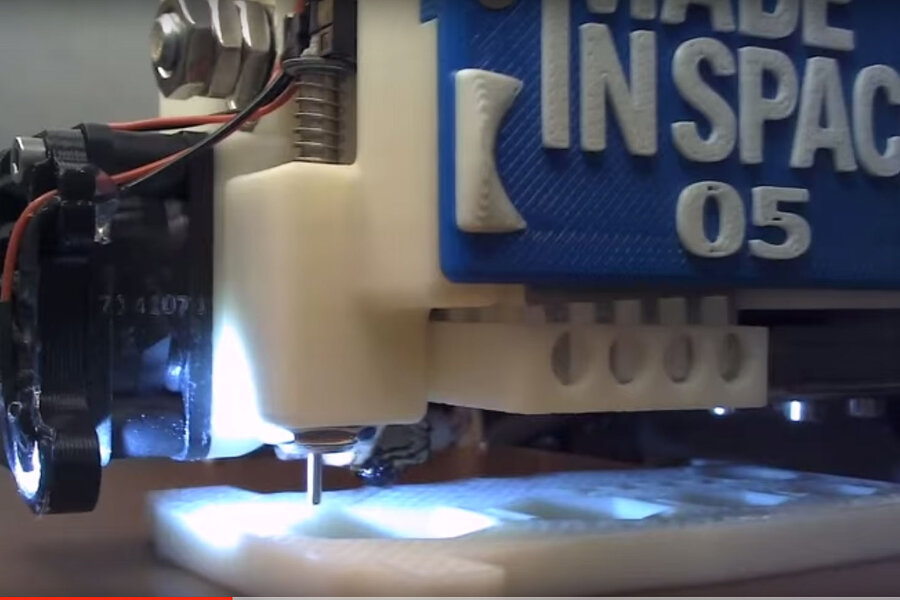A 3-D printer is working in space: Why that's a big deal
Loading...
In what became a defining moment of 20th-century engineering, NASA scientists flurried to "invent a way to put a square peg in a round hole – rapidly" and made a filter using only materials available to the astronauts aboard the Apollo 13 lunar mission.
The evolving technology of 3-D printing has the potential to both streamline that type of zero-gravity problem-solving and move NASA closer to Mars exploration.
"Think of Apollo 13 when parts failed," Grant Lowery, marketing and communication manager for NASA's partner in 3-D printing, Made In Space, told The Christian Science Monitor in 2014. "No more duct tape, or square pegs into round holes in a panic."
NASA has encouraged 3-D-printing innovations with a high school student contest, giving the winner an opportunity to watch as astronauts print the design. The winning design came from Robert Hillan, now an engineering student at the University of Alabama. Mr. Hillan observed the printing of his Multipurpose Precision Maintenance Tool alongside NASA's mission control team on Wednesday, according to a NASA press release.
Hillan used computer-aided design (CAD) to model a multi-purpose wrench with a Velcro strip for easy storage, Alabama.com reported.
"When you have a problem, it will drive specific requirements and solutions," NASA astronaut Tim Kopra told Hillan during the video chat. "3-D printing allows you to do a quick design to meet those requirements. That's the beauty of this tool and this technology."
The student's work highlighted another key benefit of 3-D printing. Engineers and designers can transfer templates they create on Earth to the International Space Station (ISS) by the "snail mail" of cargo shipments or send them remotely. This would shorten the time needed to problem-solve between astronauts and the engineers on the ground.
"When a part breaks or a tool is misplaced, it is difficult and cost-prohibitive to send up a replacement part," said Niki Werkheiser, manager of NASA's 3-D Printer program, in a NASA press release. "With this technology, we can build what is needed on demand instead of waiting for resupply. We may even be able to build entire structures using materials we find on Mars."
Although 3-D printing, also known as additive manufacturing, can include several techniques, the unique demands of a space environment make fused deposition modeling (FDM) the most practical. Other methods laser-harden a vat of liquid or powder, requiring more stability than a zero-gravity environment can offer. The advantage of an FDM printer is its glue gun-like nozzle, which completes each layer before moving to the next. These FDM printers deposit layers of melted polymer atop a stable plate using a pre-designed template.
FDM-style 3-D printers have a size advantage as well. They can be quite small – the printer on board the ISS is the size of microwave. The ISS model uses an acrylonitrile butadiene styrene (ABS) thermoplastic resin, the same polymer used to make Legos.
NASA sent its first 3-D printer to the ISS in September 2014, and it has printed 25 parts since then. Space is not only the next frontier for 3-D printing, but possibly its most practical, because the technology is most practical in prototyping or single-use manufacturing. Made In Space intends 3-D printing to not only give astronauts a means of printing the parts they need for repairs – a filter, for example – but also take advantage of zero-gravity conditions to manufacture otherwise-impossible designs.
Astronauts on the ISS installed the first Made In Space facility for 3-D printing at the end of April. The chief executive officer of the California start-up Andrew Rush called the new additive manufacturing facility "a big moment for commercial space" because it offers remote access to designers on the ground. Ultimately, it could function like "a machine shop in space," giving contractors who want to launch their projects into orbit a laboratory for testing new designs.








